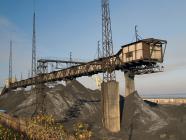Competing Forces Clash over Coal Ash
Issue tied to presidential outcome

Two competing forces with regard to how coal ash
is regulated are headed for a collision.
Environmentalist groups have just said that they
would sue the U.S. Environmental Protection Agency
to force prompt action while U.S. lawmakers from
coal-producing states are working to head off those
attempts.
EPA, ironically, is sympathetic to the views of the
green movement. Yet, it has not budged since its
2010 deadline to rewrite the rules that affect coal
ash and how it will ultimately be disposed.
Earth Justice and a multitude of other
environmental organizations will therefore force the
agency’s hand by filing suit in a move that would
get coal ash reclassified as a hazardous waste to
fall under the Resource Conservation and Recovery
Act.
“The EPA’s violation of the three-year statutory
deadline for revision of regulations pertaining to
coal ash places hundreds of communities at great
risk,” writes Lisa Evans, an Earth Justice attorney,
in a letter to EPA Administrator Lisa Jackson. “Thus
... we will ask the the court to direct EPA to
complete its review ....”
Coal-burning power plants consume 1 billion tons of
coal each year, says Earth Justice. That equates to
the production of 140 million tons of coal in the
form of fly ash, bottom ash, scrubber sludge and
boiler slag.
That effort, however, runs counter to legislation
that passed the U.S. House of Representatives last
October. That measure would empower the states to
continue regulating coal ash. Right now, it is
considered a solid waste that allows it to be
recycled and used in the production of such things
as cement and dry wall. The states are unlikely to
tamper with that re-use but may, in fact, tighten
the rules to mitigate the odds of spills.
About 40 percent of all coal ash is recycled. Any
attempt to reclassify that byproduct as a hazardous
waste would stigmatize it, making it more likely
that it would pile up in pools and landfills, and
less probable that it would re-used, says the Edison
Electric Institute.
The likelihood, however, that such a bill will pass
the Democratically-controlled U.S. Senate is small.
Previous efforts to dull the impact of EPA have died
on the vine. Nevertheless, the counterforce could
serve to weaken future coal ash regulations,
allowing the states to maintain a leadership role.
“This legislation gives us a common sense fix: Let
each state use existing EPA health and environment
regulations to set up their own permitting program
that allows them to recycle and reuse coal ash,”
says
Rep. David McKinley, R-WV, the bill's author.
“This approach will protect jobs and our economy,
and give families and businesses the certainty they
need to help restore confidence.”
Heavy Lobbying
The issue is expected to come to a boil now that a
U.S. District Court is deciding damages in a coal
ash spill that occurred in TVA’s territory. On
December 22, 2008, a dam burst that enabled the
escape of 5.4 million cubic yards of coal ash about
40 miles west of Knoxville, Tenn. -- something that
EPA said was an unequaled environmental disaster
that must be remedied with new regulations.
But this is a presidential election year and the
role of politics has invariably seeped its way into
the process. Even Earth Justice acknowledges this
dynamic, saying that the administration can’t evade
the heavy lobbying tactics that have sidelined the
regs.
The agency reviewed the issue, noting that 49 coal
ash sites in 12 states had "high hazard" potential
if they should fail. It also identified 71 other
sites that it said are responsible for the leakage
of heavy metals into ground water.
In EPA’s ideal world, coal ash would be regulated as
a hazardous waste. A more practical solution,
however, is to mandate new disposal standards, to
which industry seems amendable. For example, coal
ash is now discarded as a liquid that goes into
large surface impoundments or as a solid that is
placed into landfills. EPA would like to see all
such byproducts converted from “wet ash” to “dry
ash” and buried in secured liners -- a move that TVA
is already making.
Regardless of how it is regulated, the
administration would allow coal ash to be re-cycled.
“The
Administration supports the development,
implementation, and enforcement of appropriate
standards for facilities managing coal ash, while
encouraging the beneficial use of this economically
important material.”
Any movement, though, will have to wait until the
November election. Whoever wins will then direct the
fate of coal ash, which is now edging toward a
compromise of the two competing visions.
EnergyBiz Insider is the Winner of the 2011 Online
Column category awarded by Media Industry News, MIN.
Ken Silverstein has also been named one of the Top
Economics Journalists by Wall Street Economists.
Follow Ken on www.twitter.com/ken_silverstein
energybizinsider@energycentral.com
Copyright © 1996-2011 by CyberTech, Inc. All rights reserved.
To subscribe or visit go to: http://www.energycentral.com
To subscribe or visit go to: http://www.energybiz.com